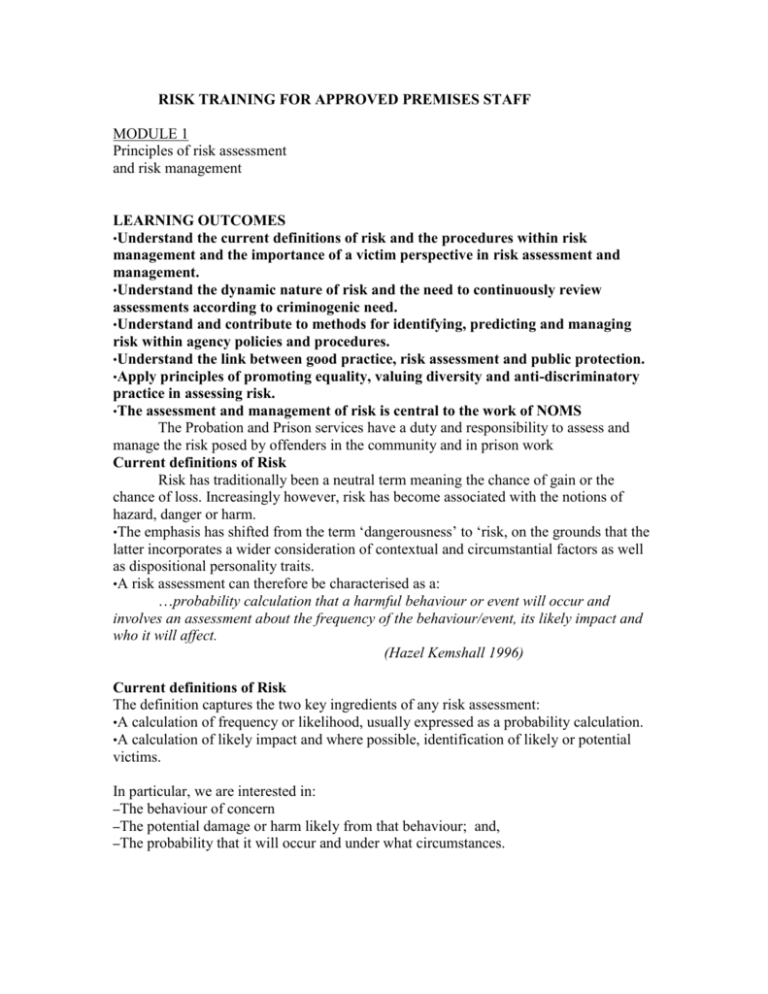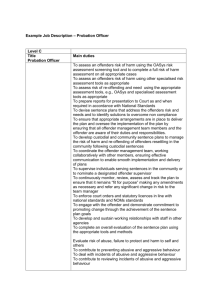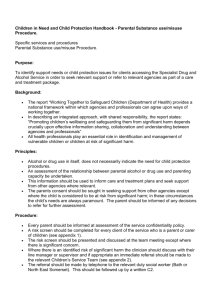RISK TRAINING FOR APPROVED PREMISES STAFF MODULE 1
advertisement

RISK TRAINING FOR APPROVED PREMISES STAFF MODULE 1 Principles of risk assessment and risk management LEARNING OUTCOMES •Understand the current definitions of risk and the procedures within risk management and the importance of a victim perspective in risk assessment and management. •Understand the dynamic nature of risk and the need to continuously review assessments according to criminogenic need. •Understand and contribute to methods for identifying, predicting and managing risk within agency policies and procedures. •Understand the link between good practice, risk assessment and public protection. •Apply principles of promoting equality, valuing diversity and anti-discriminatory practice in assessing risk. •The assessment and management of risk is central to the work of NOMS The Probation and Prison services have a duty and responsibility to assess and manage the risk posed by offenders in the community and in prison work Current definitions of Risk Risk has traditionally been a neutral term meaning the chance of gain or the chance of loss. Increasingly however, risk has become associated with the notions of hazard, danger or harm. •The emphasis has shifted from the term ‘dangerousness’ to ‘risk, on the grounds that the latter incorporates a wider consideration of contextual and circumstantial factors as well as dispositional personality traits. •A risk assessment can therefore be characterised as a: …probability calculation that a harmful behaviour or event will occur and involves an assessment about the frequency of the behaviour/event, its likely impact and who it will affect. (Hazel Kemshall 1996) Current definitions of Risk The definition captures the two key ingredients of any risk assessment: •A calculation of frequency or likelihood, usually expressed as a probability calculation. •A calculation of likely impact and where possible, identification of likely or potential victims. In particular, we are interested in: –The behaviour of concern –The potential damage or harm likely from that behaviour; and, –The probability that it will occur and under what circumstances. Current definitions of Risk Harm is understood as psychological as well as physical, sexual and violent harm. •Risk assessment is a constant process involving risk management, review of its effectiveness and re-assessment. •Re-appraisal in cases of escalation or reduction of risks, bearing in mind that risks change over time and in differing contexts. •Risk is uncertain – only relative probabilities can be estimated. Current definitions of Risk Remember: We Can Never Eliminate Risk But Seek To Manage Risk Through Harm Reduction What Do We Mean By Risk? Risk of Harm •An estimate or assessment of the likely level of harm or dangerousness posed by an individual offender Risk of Reconviction •The probability or likelihood of an offender committing a further offence Risk of Serious Harm: Definition Harm which is life threatening and / or traumatic and from which recovery, whether physical or psychological, can be expected to be difficult or impossible. Harm Categories •Low •Medium To •High •Very High Risk of Harm Levels •Low •no significant, current indicators of risk of harm •Medium •identifiable indicators of risk of harm •Offender has the potential to cause harm but is unlikely to do so unless there is a change in circumstances. Risk of Harm Levels •High •identifiable indicators of risk of serious harm •potential event could happen at any time and impact would be serious •Very High •imminent risk of serious harm •potential event is more likely than not to happen imminently •the impact would be serious Remember We have a greater duty of care to •Children •Staff •Prisoners/Group members Assessors will be concerned with any risk of harm and the category is based on imminence. Risk Management •Offender management plans, strategies or interventions used by practitioners with the aim of reducing or controlling the risk level posed by an individual offender General Principles •Identify what can be changed - not everything can be! •Target specific behaviours, situational triggers, conditions, circumstances •Reduce access to situations and limit the stressors or triggers •Protect potential victims •Listen to information from significant parties (including offender’s relatives) and act on warning signals •Recognise when effective work is NOT possible and your role becomes one of: monitoring, surveillance and control (Hazel Kemshall 1997) Risk Management Strategies •Multi-agency adds value •External Controls e.g.: licence conditions •Surveillance and monitoring •Enforcement strategy/Contingency plans •Offence focussed work •Programmes •Constructive Interventions e.g: ETE •Supportive Measures •Victims •Diversity Legislation Victims Charter 1990, 1996 Criminal Justice Act 1991 Crime and Disorder Act 1998 Criminal Justice and Court Services Act 2000 Criminal Justice Act 2003 Sex Offenders Act 2003 Context for Risk Policy and Practice •Emergence of public protection as a primary objective •Reduction of re-offending and harm •National Standards •Importance of Multi–agency approach •What works •Key to Offender Management •MAPPA Context for Risk Policy and Practice •The role of the media •Tragedies •Public scrutiny •Defensibility •Accountability •Legislative reform •Serious Further Offences Defensible decisions •It is important to acknowledge that risk assessment is a highly fallible undertaking and it is unlikely that any method can be found which will provide certainty and 100% levels of accuracy for worker, agency and public. •In situations where accuracy cannot be guaranteed, the key to decisions withstanding subsequent accountability and public scrutiny is their defensibility. In other words, how decisions are evaluated with hindsight after negative outcomes have occurred and whether decisions can be considered to be ‘reasonable’. Defensible decisions A defensible decision is made when: •all reasonable steps have been taken •reliable assessment methods have been used •information is thoroughly evaluated •decisions are recorded •staff work within agency policies and procedures •staff communicate with others and seeks information they do not have Defensible decisions •‘The very worst practice doesn’t involve making wrong decisions, but no decisions at all’ (Herschel Prins) How Do We Assess Risk? •e-OASys •OGRS •SARA •Risk Matrix 2000 •Local AP specific assessment Sources of Information 1 •Pre-cons •CPS Papers •Case Records •Previous Reports •Previous Risk •Assessments •Hostels' referral form •Prisons •MAPPA notes •Informal information Sources of Information 2 •Medical Services •Psychiatric Services •Police Intelligence •Family/Partner •Drug/Alcohol Agency •Social Services •Your Interview Risk Factors 1 •Drug and alcohol use •Violent and aggressive behaviour •High levels of anger/hostility •Use of weapons •Mental Health •Active symptoms - particularly psychotic symptoms such as delusions and hallucinations •Clinical diagnosis •Medication non compliance •Identified victims or target group •Thinking skills Risk Factors 2 •Identified victims or target group •Thinking skills •Relationships •Social isolation •Financial difficulties •Lack of accommodation •Lack of employment •Sexual offending •Lifestyle and associates •Failure to attend appointments General Principles of Risk Assessment •Risk cannot be eliminated •Risk is dynamic: it is constantly changing, sometimes even over short spaces of time •Risk may be general or specific •Rigorous assessment and good practice can reduce risk •Good risk assessment cannot be done in isolation We need to know.......... •How serious is the risk? •How likely is the risk? Actuarial and Clinical Assessments There are two basic approaches to risk assessment for offenders •Actuarial, based on statistical calculations of probability (well used in the insurance industry). •Clinical, a diagnostic assessment derived in part from the medical and mental health fields. It is now generally accepted that the accuracy and consistency of risk assessments is enhanced by assessment tools which combine actuarial calculations of probability with detailed clinical interviewing, to establish the conditions and circumstances under which risky behaviour might occur. Actuarial and Clinical Assessments Aims of e-OASys To deliver a common, efficient and effective offender risk and needs assessment system that enables the prison and probation service to achieve Home Office targets for reduction in re-offending/reconviction rates and for increased protection of the public. e-OASys: Evidence of Risk •Section 1: Case ID & Offending Information •Section 2: Offence Analysis •Sections 3-12: Offending Related Factors •Section 13: Health & and other considerations •Risk of Harm Screening •Self assessment MAPPA Key Processes •Identification of offenders •Information Sharing •Risk Assessment •Risk Management Components of a good risk of harm assessment •Full information concerning the offender •Uses actuarial and clinical data •Analysis of risk factors (to whom/under what circumstances) •Risk Triggers (what will increase/reduce risk) •A plan to manage the identified risk •Communication with all interested parties •Clarification of roles and responsibilities Be Alert for Changes Situational Factors •Address •Relationships •Job •Offender Manager Be Alert for Changes Presentation •Under the influence •Hygiene •Mood •Non compliance •Over compliance Always Remember..... •Be vigilant! •Explore/Investigate! •Ask the unthinkable •Communicate (Who needs to know ?) •Be aware of Diversity and Equal Opportunities •Liaise •Think victim References •Kemshall, H (1996) Reviewing Risk, A Review of Research in the Assessment and Management of Risk and Dangerous. Home Office •Kemshall, H (1997) Risk And Parole: Issues in Risk Assessment And Release in Kemshall, H & Pritchard, J (eds) Good Practice in Risk Assessment and Risk Management London: Jessica Kingsley •Kemshall, H (2001) Risk Assessment and Management of Known Sexual and Violent Offenders. Police research Series Paper 140. Home Office •Powis, B (2002) Offenders’ Risk Of Serious Harm: A Literature Review. Home Office •Prins, H (1999) Will They Do It Again London: Routledge •Brown, Angela; Forbes, David (2005) Core Curriculum Learning Programme for PSO Induction and Development 2005-2006 Module 5; London Probation





